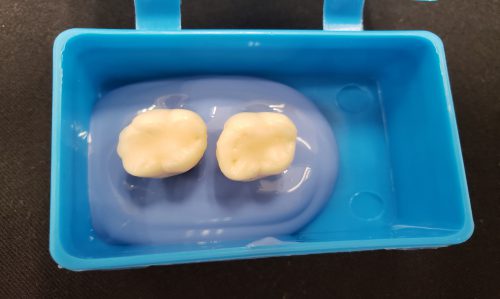The combined material may reduce and even prevent the effects of inflammation and recurrent caries, which cause the need for root canal treatments and tooth extractions; It is of great interest among dental specialists * The article was recently published in the journal ACS Applied Materials and Interfaces

Researchers at Tel Aviv University, led by Dr. Lehi Adler-Abramovich from the School of Dentistry and the Center for Nanotechnology, in collaboration with Lee Schneider and Prof. Ehud Gazit from the Department of Molecular Microbiology and Biotechnology, have developed a revolutionary material that may significantly improve the quality of dental restorations (known to the general public as fillings'), and add antibacterial properties to them that will reduce repeated damage to the tooth. Other partners in the research are Prof. Rafi Filo, Prof. Tami Brosh and Dr. Rachel Sharig. The innovative material arouses great interest among experts and companies in the field of dentistry.
The article was published in June 2019 in the scientific journal ACS Applied Materials and Interfaces, one of the leading journals in the fields of chemistry and materials engineering.
"Many of us remember well, and even carry in our mouths, the amalgam - that silver mixture that dentists used to fill and restore teeth after drilling and removing the damaged parts," says Ms. Schneider. "Nowadays, it is more common to use what is known as 'white fillings', which are made of a composite material that is more aesthetic, but it also has a significant drawback: the amalgam contained, among other things, silver, which is an antibacterial substance, whereas the materials commonly used today do not have such a property. This means that caries-causing bacteria can colonize the tooth again relatively easily, thus increasing the need for repeated treatments, which may even worsen to root canal treatment or tooth extraction. We sought to improve the new materials by adding nanostructures with antibacterial activity."
For this purpose, the researchers developed nanostructures made of relatively simple building blocks that coalesce together in a basic process of self-assembly. Each of the building blocks is made of a single amino acid, to which two parts are added - a part that encourages self-assembly and a part that contains fluorine, an antibacterial substance found, among other things, in toothpastes. The nanostructures created were flexible and strong, and a laboratory experiment showed that they were effective against bacteria, and in particular against Streptococcus mutans, which is the main cause of caries in human teeth.
"In the next step, we moved to material engineering technologies, and combined the material we developed with the common composite material, which is used to restore teeth in many clinics," says Dr. Adler-Abramovitz. "The combination process was efficient and relatively simple due to the flexibility of the nanostructures, and in the end a new composite material was obtained, which meets the requirements of dentists: a strong material with a white and aesthetic color, which combines high-quality mechanical and optical properties with the extremely important ability to destroy bacteria."
"Our research combined many different fields of science - biotechnology, nanotechnology, biophysics, microbiology and materials engineering," concludes Ms. Schneider. "In addition, it is an example of how properties in the nanometer dimensions can affect the engineering of materials in larger dimensions. The antibacterial material we developed for tooth restoration is of great interest among scientists and dentists alike, and we believe that our method has significant potential for additional uses as well. Today we are working on the combination of antibacterial nanostructures in fabrics, to create antibacterial fabrics for use in hospitals and dressings. In the future, it is possible that such nanostructures will also be incorporated into implants inserted into the body, in order to prevent infections around the implant."
More of the topic in Hayadan:
